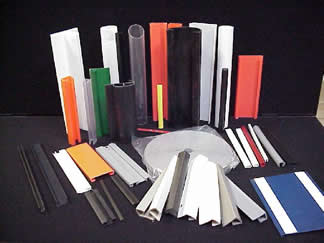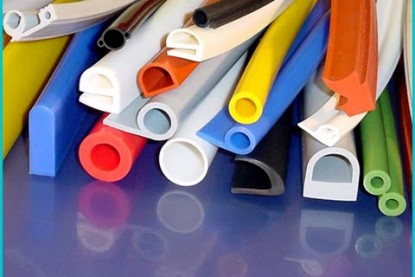Proudly Extruded in the US
Custom color matching, vacuum calibration, in-line laser gauging, optical comparator, CAD, extrusion design assistance, in-house tooling.
25 extruders ranging in size from 1″ to 4.5″ barrel diameter and 60mm twin screw.
Rigid – Flexible -dual-durometer (co-extrusion). Maximum profile height and width – approximately 2″ x 6″ Maximum length (rigid) – 55′.
We specialize in complex close tolerance profiles. Our experience combined with the latest extrusion technology give us a competitive edge.
All extrusion dies are produced in-house using state-of-the-art 4-axis CAD programmed wire EDM. Our expertise can turn even the most exacting challenge into successful results. We specialize in custom extrusions and in-line fabrication, eliminating costly secondary processing and handling.
Some major industries served are: Commercial Refrigeration, Recreation, Transportation, Building and Fence.
Process:
The plastic extrusion process starts with the placement of raw resin into the extruder’s main hopper. If the used resin lacks the additives necessary for the desired application (such as anti-oxidants, UV inhibitors, or colorants), they are then added to the hopper when needed. Once in place, the resin is gravity-fed through the feed throat of the main hopper down into the barrel of the extruder. Inside the barrel is a long rotating screw that feeds resin forward in the barrel towards the used die.
As the resin moves within the barrel, it is subjected to precisely maintained high temperatures as it melts. Depending on the type of thermoplastic, barrel, temperatures can range between 400 and 530 degrees Fahrenheit. The extruder can have a barrel that gradually increases in heat from the loading end to the feed pipe to aid in the gradual melting and minimize the possibility of any plastic degradation.
Once the molten plastic reaches the barrel’s end, it is squeezed through a screen pack and then fed into the main feed pipe that leads to the chosen die. The screen, which is reinforced by a breaker plate due to the high pressures in the barrel, serves to remove any contaminants that could be present in the molten plastic. The screens porosity, number of screens, as well as other factors can be manipulated until uniform melting occurs as a result of the right amount of back pressure.
Once in the primary feed pipe, the molten plastic is fed into the die cavity, where it cools and hardens. To control the cooling process, the newly formed plastic receives a special fluid bath.
Materials
Rigid and flexible PVC
PVC alloys
High and low density polyethylene
Polypropylene
Polystyrene
Santoprene
Alcryn
Thermoplastic rubber
TPE’s
TPU’s
Thermoplastic polyurethane
Acrylics
ABS
Single and multiple durometer extrusions.


